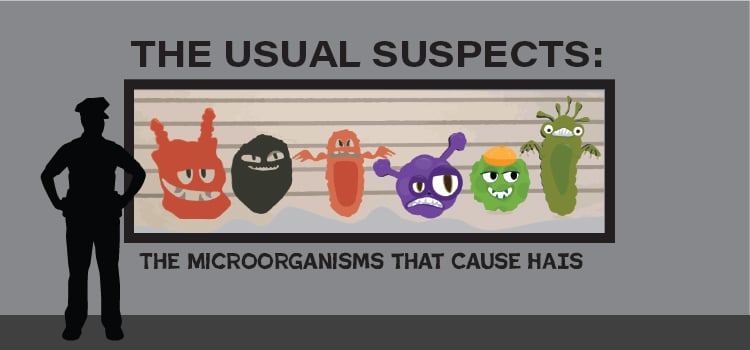Ask the Expert: The CRE Superbugs
 Right now there is a lot of attention being given to a group of bacteria called carbapenem-resistant Enterobacteriaceae (CRE). There have been two outbreaks reported by news outlets so far. FIrst, there was an outbreak at UCLA’s Ronald Reagan Medical Center linked to procedures with a contaminated endoscope resulting in two deaths and possibly many more infections. More recently, there was an outbreak at the Carolinas HealthCare System where 18 people this year have been reported with CRE.
Right now there is a lot of attention being given to a group of bacteria called carbapenem-resistant Enterobacteriaceae (CRE). There have been two outbreaks reported by news outlets so far. FIrst, there was an outbreak at UCLA’s Ronald Reagan Medical Center linked to procedures with a contaminated endoscope resulting in two deaths and possibly many more infections. More recently, there was an outbreak at the Carolinas HealthCare System where 18 people this year have been reported with CRE.
How does this affect you? Should you be worried? Antibiotic resistance has the potential to affect us all - it is a vital, life-saving therapy that has revolutionized medicine. CRE is possibly an early warning sign of what could be in our future if we do not address the issue of antibiotic resistance. In this piece we will try to introduce you to CRE and provide the latest available information about this "superbug."
What is CRE?
Carbapanem-resistant Enterobacteriaceae (CRE) are a very large family of bacteria (over 70 types are known) that are normally found in the gut of humans and animals. Organisms like E. coli and Klebsiella pneumoniae are well known examples of Enterobacteriaceae. The "carbapenem-resistant" part of the name stems from the fact that CRE are resistant to not only more traditional antibiotics such as penicillin, but also to a group of antibiotics called carbapenems. Carpabamens are often called "last resort antibiotics" because they kill a wide range of bacteria that cause infections. But just as you wouldn't dig a hole in your backyard with an excavator when a shovel would do, physicians do not attack simple infections with carpabanems. But it's great to have them available if the infection does not respond to the basic antibiotics.
How are they resistant to antibiotics?
There are many ways that the CRE are resistant to carbapenems, but the predominant method is via production of an enzyme called a carbapenemase which can break down carbapenem antibiotics efficiently. But they weren't always able to do this as a species. CRE became resistant due to antibiotic misuse or overuse which selects for those bacteria that can survive antibiotic therapy. Once these resistant bacteria are "selected for" (survive) and the rest of the bacteria are killed off, they start to grow and multiply. Soon the resistant bacteria are the predominant bacteria, which makes the infection very difficult to treat. To complicate matters, the CRE resistance mechanism is encoded on DNA which is easily shared amongst members of the Enterobacteriaceae. This means the resistance can hop around from bacteria to bacteria sharing the resistance broadly and widely.
What can CRE do?
Enterobacteriaceae are a diverse family of bacteria with many members, some of which are beneficial and can be found in your gut flora. Some members of this family, however, contain organisms that are pathogenic (known to cause disease) and can cause a range of illnesses including pneumonia, urinary tract infections and blood stream infections. Some of the members of this family can produce and release toxins that are also detrimental to your health.
Why are they of concern?
CRE are of concern as they can be so difficult to treat due to being resistant to a lot of the common antibiotics that are prescribed to treat infections. The CDC has found that they can cause a high rate of mortality (up to 50% in patients who end up with a bloodstream infection), and are spreading around the nation fast with 42 states reporting CRE in medical facilities in the last 10 years. In only the first half of 2012, about 4% of US hospitals and 18% of long term care facilities reported at least one patient with CRE.
How can I “catch” CRE?
Most healthy people do not get these infections. People who get these infections are typically on antibiotics, are in long term care facilities, nursing homes or are patients in a hospital. People who have had a procedure with a medical device are also at risk of CRE. In order to become infected, you would first need to have contact with the CRE bacteria through physical contact with a person who is infected (contact with infected wounds or waste products) and then have access for the bacteria to enter your body such as a surgial incision, a wound, or a medical device introduced to your body.
Can CRE be treated?
There are some limited options available that can be used to treat CRE infections; however, each infection and CRE resistance profile can be slightly different. Other therapies (such as draining infections) can be used depending upon the infection.
Why do some people contract a CRE infection and others don’t?
People who do not have an infection may still have CRE but they are described as “colonized." The CRE is in or on their body but has not yet caused an infection or a problem. These people do not need antibiotics, but any known CRE may be removed prior to a medical procedure.
Are these new superbugs?
CRE are unfortunately not new (relatively speaking). The CDC had initial reports of CRE in early 2001. In 2013 the CDC identified CRE as one of the Urgent Threats of all antibiotic resistant microbe threats due to the lack of treatment options and the increasing spread of these organisms.
How can I prevent CRE?
- Tell your doctor if you have been hospitalized in another facility or country.
- Ask your care givers if they have washed their hands before touching you.
- Only take antibiotics prescribed to you and complete the entire dose.
- Clean your own hands especially after contact with wounds or after using the bathroom.
What is currently being done about CRE?
The FDA has released an advisory on additional cleaning practices for duodenoscopes (the devices used in the UCLA outbreak) to address any contamination concerns. If you are concerne, ask your healthcare provider about additional decontamination steps that are being performed to keep you safe.
The CDC website also has guidance available to both healthcare professionals and to patients on how to decrease transmission of CRE (including a CRE toolkit), as well as how to treat and deal with CRE infections.
Where can I find more information?
About Hospital Acquired Infections
Dr Monk is the Director for Clinical and Scientific Affairs for Cupron Inc, a biotech firm based in the Richmond , VA area focusing on utilizing its novel proprietary platform technology involving the use of copper compounds in synthetic polymers for consumer, medical, industrial and military applications. Dr. Monk’s area of expertise is microbiology and antimicrobial’s mode of action and resistance, and he is responsible for managing clinical and research trials in the United States, and executing regulatory strategy in the United States for Cupron Inc. Prior to joining Cupron, Dr. Monk was Head Scientist at Biocontrol Ltd developing novel antibacterial solutions for antibiotic resistant bacteria. Dr. Monk received his PhD in Microbiology and Molecular Epidemiology from Bath University and B.Sc. in Biology and Microbiology from the University of Birmingham. Dr. Monk performed his post doctoral studies at Virginia Commonwealth University focused on antimicrobial’s mode of action and resistance.
![EOScu Logo - Dark - Outlined [07182023]-01](https://blog.eoscu.com/hubfs/Eoscu_June2024/Images/EOScu%20Logo%20-%20Dark%20-%20Outlined%20%5B07182023%5D-01.svg)




